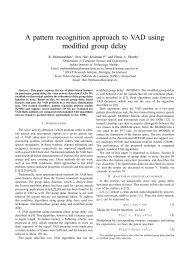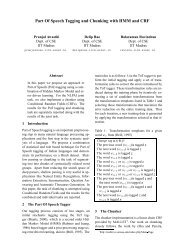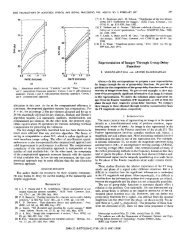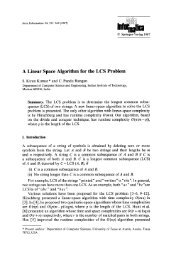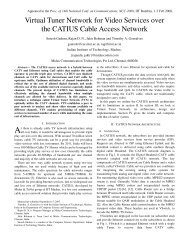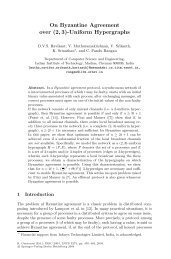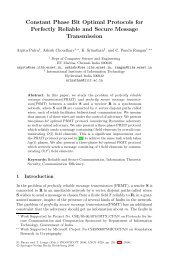TRANS: Schema-Aware Mapping of OWL Ontologies into Relational ...
TRANS: Schema-Aware Mapping of OWL Ontologies into Relational ...
TRANS: Schema-Aware Mapping of OWL Ontologies into Relational ...
You also want an ePaper? Increase the reach of your titles
YUMPU automatically turns print PDFs into web optimized ePapers that Google loves.
1.1.3 Types <strong>of</strong> Inference Strategy<br />
There are two types <strong>of</strong> inference strategies for ontology<br />
reasoners.<br />
1. Load time inference: In load time inference, we<br />
compute and store the closure <strong>of</strong> a given graph as<br />
a basis for querying. Genea[7] is an example <strong>of</strong><br />
Load time inference reasoner.<br />
2. Query time inference: Query time inference<br />
strategy allows the query processor infer new<br />
statements as needed per query. DLDB[9] and<br />
Seasame[2] use query time inference as their ontology<br />
reasoning strategy. <strong>TRANS</strong> is also a query<br />
time inference reasoner.<br />
1.2 Related Work<br />
Related work in ontology mapping can be classified<br />
<strong>into</strong> two types.<br />
<strong>Schema</strong>-oblivious mapping Seasame[2] is a schema<br />
oblivious approach for mapping RDF[15] AND RDF<br />
<strong>Schema</strong>[14]. Seasame design is independent <strong>of</strong> any<br />
specific storage devices. Underlying structure <strong>of</strong><br />
Seasame schema is <strong>of</strong> triple format[1, 11]. Seasame<br />
inserts inferred triples in the database table at the<br />
load time itself. This feature significantly increases<br />
the loading time for RDF and RDFS. Seasame<br />
schema is ontology independent means the structure<br />
<strong>of</strong> schema is fixed irrespective <strong>of</strong> ontology.<br />
<strong>Schema</strong>-aware mapping DLDB[9] is a knowledge<br />
based system, proposes a new schema-aware<br />
mapping approach for mapping <strong>OWL</strong> ontologies.<br />
It extends RDBMS with additional capability for<br />
DAML+OIL[18] inference. DLDB uses FACT description<br />
logic reasoner for computing <strong>OWL</strong> subsumption<br />
inference. It uses RDBMS views for storing class<br />
and property subsumption results. They have done<br />
light weight implementation <strong>of</strong> their approach using<br />
MS-Access and FACT[4] reasoner. DLDB presents<br />
the scaling performance <strong>of</strong> their system with increase<br />
in number <strong>of</strong> instances in the RDBMS and proves<br />
that idea <strong>of</strong> extending relational databases using<br />
description logic is feasible.<br />
The most closely related to our work is Genea[7].<br />
Genea[7] is a schema-aware mapping approach for<br />
mapping <strong>OWL</strong> ontologies <strong>into</strong> relational databases.<br />
It maps the basis <strong>of</strong> set <strong>of</strong> mapping rules. Genea<br />
maps each simple named classes to a separate relation<br />
and individuals to rows in (one or more) relations.<br />
Similarly for simple data and object property<br />
a separate relation is created in relational database.<br />
Main differences between Genea and <strong>TRANS</strong> are as<br />
follows: Genea uses materialization technique at load<br />
time for <strong>OWL</strong> subsumption inference, while <strong>TRANS</strong><br />
uses query time inference for <strong>OWL</strong> subsumption inference.<br />
Genea creates a separate relation for simple<br />
named class and property. On the other side, <strong>TRANS</strong><br />
creates a separate relation for each directed acyclic<br />
graph in ontology concept hierarchy.<br />
1.3 The Body <strong>of</strong> The Paper<br />
The remainder <strong>of</strong> paper is organized as follows. Section<br />
2 describes the architecture <strong>of</strong> <strong>TRANS</strong>. In section<br />
3, we describe <strong>TRANS</strong> mapped schema for LUBM<br />
University ontology fragment. Section 4 shows experimental<br />
setup. The results <strong>of</strong> an experimental evaluation<br />
<strong>of</strong> our mapping rules compared to Genea are<br />
presented in the section 5 and 6. Section 7 list <strong>of</strong> some<br />
intentional queries which <strong>TRANS</strong> can answer. The<br />
next section concludes.<br />
2 Architecture <strong>of</strong> <strong>TRANS</strong><br />
Figure 1 depicts the components involved for the complete<br />
mapping process. The architecture description<br />
is as follows:<br />
Definition 1. Let { D 1 , D 2 , D 1 ... D n } is a set<br />
<strong>of</strong> disjoint directed acyclic graph extracted out<br />
<strong>of</strong> concept hierarchy <strong>of</strong> an ontology O, D ir is a<br />
root node <strong>of</strong> the D i and D il is a leaf node <strong>of</strong> the<br />
D i then a transitive chain is a path <strong>of</strong> nodes<br />
< D ir , p 1 , p 2 ,... p n , D il > between D ir and D il<br />
including both D ir and D il . Here p 1 , p 2 ,... p n are<br />
intermediate nodes between D ir and D il .<br />
Definition 2. Let T i is a transitive chain and { N r ,<br />
N r+1 ,.... N l } is the set <strong>of</strong> nodes in the transitive<br />
chain Ti. Leveling is the process <strong>of</strong> numbering<br />
the nodes considering the constraint that for each<br />
node N i level Number <strong>of</strong> N i should be less than<br />
level number <strong>of</strong> N i+1 .<br />
Definition 3. Let { T 1 , T 2 , T 1 ... T n } is set <strong>of</strong><br />
transitive chains <strong>of</strong> disjoint directed acyclic graph<br />
D i (as mentioned in Definition 1) and D in is a node<br />
in the D i . If D in passes through the r transitive<br />
chains < T j , T j+1 , ... T j+r > with levels value<br />
< l j , l j+1 , ... l j+r > then normalization is the<br />
process <strong>of</strong> giving Max( l j , l j+1 , ... l j+r ) to node<br />
D in . Here Max represents maximum level value<br />
<strong>of</strong> all level numbers in < l j , l j+1 , ... l j+r >.<br />
2.1 <strong>TRANS</strong> Relation Generator<br />
<strong>TRANS</strong> uses the Jena[17] parser for parsing the<br />
input ontology file. The <strong>TRANS</strong> relation generator<br />
generates the relations out <strong>of</strong> ontology concept data.<br />
Relations are created in relational databases for<br />
the ontology through <strong>TRANS</strong> rules for mapping.<br />
Following are the <strong>TRANS</strong> schema-aware mapping<br />
rules.



